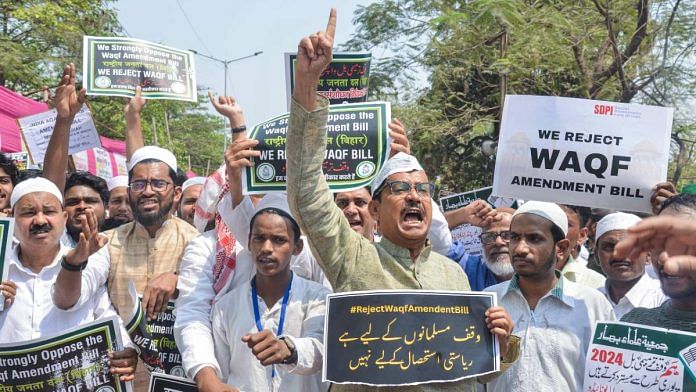New Delhi: Hearing petitions challenging the Waqf (Amendment) Act, 2025, the Supreme Court Wednesday focused on four major issues—application of the Act, government property declared as waqf, constitution of the Central Waqf Council, and composition of state waqf boards.
These were drawn from a batch of nearly 100 petitions challenging the law, and revolve around significant changes to waqf governance and property recognition.
The bench, headed by Chief Justice of India Sanjiv Khanna along with Justices P.V. Sanjay Kumar and K.V. Viswanathan, flagged the issues for their potential to disturb status quo and create disharmony. ThePrint explains the four elements and changes with respect to the Waqf Act of 1995.
Also Read: 1995 Waqf Act balanced Islamic principles and Indian law. Amendment Bill shifts the scales
Application of Act, Section 2
Section 2 of the Waqf (Amendment) Act excludes private trusts that have been so far treated as waqf pursuant to a court order.
“Provided further that nothing in this Act shall, notwithstanding any judgement, decree or order of any court, apply to a trust (by whatever name called) established before or after the commencement of this Act or statutorily regulated by any statutory provision pertaining to public charities, by a Muslim for purpose similar to a waqf under any law for the time being in force,” it states.
It nullifies the effect of any past or existing court decision that declared or treated a Muslim-run trust as waqf, meaning thereby that even if there were rulings that considered a Muslim charitable trust as being equivalent to a waqf (in terms of its religious or charitable purposes), the new law will treat the trust under the public charity framework, and not as waqf.
There is explicit exclusion of trusts from the waqf Act, even if they serve waqf-like purposes and were established by Muslims.
According to Section 2, even if a trust’s purpose is similar to a waqf, such as religious or charitable functions, it will not be treated as waqf. This is important because, under previous laws, some trusts might have been treated as waqf-like entities, even though they were legally categorised as trusts.
Wrongful declaration of waqf, Section 3C (1)
Section 3C (1) of the amended Act states that “any government property identified or declared as waqf property, before or after the commencement of this Act, shall not be deemed to be a waqf property”.
This provision bars the classification of government-owned land as waqf, even if it was previously declared as waqf. The new amendment removes that possibility for any land that is recorded as government property, regardless of how long or how consistently it has been used for religious purposes.
It also creates a larger question about the maintenance of status quo for existing waqf property.
The Supreme Court, in its initial hearing, flagged this as a key issue for further scrutiny, particularly in light of constitutional protections for religious freedom and the right to manage religious affairs under Articles 25 and 26.
Article 26 of the Constitution grants religious denominations or communities the right to manage their own religious affairs, including the right to establish and maintain institutions for religious or charitable purposes.
Establishment of Central Waqf Council, Section 9
In the Waqf Act of 1995, under Section 9 relating to the establishment and constitution of the Central Waqf Council, clause 2 stated that it shall be composed exclusively of Muslim members, except for the Union minister in charge, who served as the chairperson.
In the 2025 amendment, the inclusion of at least two non-Muslim members in the Central Waqf Council has been mandated. Additionally, it allows room for up to 12 of 22 council members being non-Muslim.
The amendment also introduces a requirement for state and union territory waqf boards to include one representative each from the Bohra and Aghakhani communities. In addition, the boards must have two non-Muslim members, not counting the ex-officio members. The Act stipulates that if the Dawoodi Bohra and Aghakhani communities have waqf properties in a state, the respective waqf board must include one member from each of these communities.
Composition of waqf board, Section 14
Section 14 of the Waqf Act of 1995 outlines the composition of state and UT waqf boards. The 2025 amendment introduces significant changes to this section, altering the structure and representation within these boards.
In the Act of 1995, the composition of elected members in state waqf boards was: Muslim members of the state legislature; Muslim members of the state bar council and mutawallis (caretaker of waqf) with an annual income of Rs 1 lakh or more.
The composition of nominated members in the state waqf boards in the 1995 Act was: one Muslim with professional experience in fields like town planning, business management, social work, finance, revenue, agriculture or development activities; one Muslim scholar each from Shia and Sunni Islamic theology and one Muslim officer from the state government, not below the rank of joint secretary.
The latest amendment has revised the composition by mandating at least two non-Muslim members (excluding ex-officio members); at least two women members and one representative each from the Bohra and Aghakhani communities, if these communities have waqf properties in the state.
The amendment empowers state governments to nominate members to the state waqf board, including non-Muslim members, thereby altering the previous practice where members were elected from electoral colleges comprising Muslim MPs, MLAs and bar council members.
(Edited by Nida Fatima Siddiqui)
Also Read: Brahmins, BJP, and Waqf—the story of Tamil Nadu village’s fight for land




